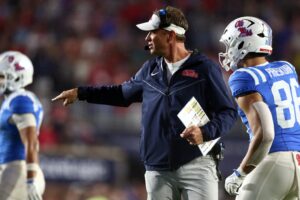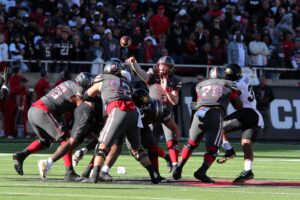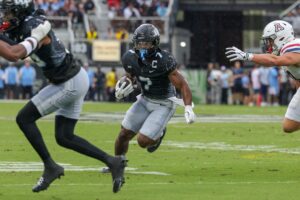.The 2020-2021 sports calendar year was one that tested college programs across the country. Some adapted to the new COVID world order within the confines of state regulations. Others led their respective state in what the regulations were going to be. It is a pointless debate to try to determine if one university handled it better than others. Most did what they had to do to get by. UCLA’s challenges were not unique in the past. But with financial woes piling up all around them, they must change going forward. That means UCLA must open the Rose Bowl completely for the upcoming football season.
UCLA Must Open The Rose Bowl
There are many complex layers to the conversation. And there is the temptation to compare what the Pac-12 and its member schools did compared to other schools and conferences around the country. But the debate about which governor handled the pandemic better or which athletic conference managed its schools better is for a different column. It isn’t this one. This one is complex for different reasons. UCLA athletics has a grim financial picture. The city of Pasadena and the Rose Bowl have financial problems. There is only one step to take.
The state of California has the lowest COVID infection rate in the country, and the county of Los Angeles has one of the lowest county rates in the country. Put all those factors into one formula and the conclusion that must be drawn is that UCLA must open the Rose Bowl to full potential capacity for the 2021 season. The school will say it is not up to them. They will say they will wait to hear from the county. It not only can be up to UCLA, it must be up to them.
The Money Tells The Story
There is enough debt to go around, so let’s start with UCLA’s. The athletic department has had two consecutive years of fiscal year debt. When the 2020-21 fiscal year is reported in the coming months, it will be three years in a row. How much the debt climbs is pure speculation to anyone outside the immediate inner circle.
In the 2018-19 fiscal year, which mirrors the academic year, the UCLA athletic department was about $18.9 million underwater. A big chunk of that was the contract buyouts for Jim Mora and Steve Alford. While there is a concept that boosters take care of the buyouts, it is a misnomer at a school like UCLA. The benefactors may donate to the department in an amount that is equal to or close to the amount of the contract buyouts. But they are not directly paying the buyouts.
We talked to UCLA athletic director Martin Jarmond just days after he took over in June 2020. The 2019-20 fiscal year numbers were not yet released. So, the only debt on his desk was the $18.9 million. He said it was going to take a new kind of creative thinking in the budget process to work through it.
Digging Out From Under
The answer was the athletic department got an interest-bearing loan from the school’s general fund. So, the debt is not gone. In fact, it is growing with the interest owed back to the school. This is the parents bailing their kids out of debt but charging them a vig to do it.
As a point of reference, in Berkeley, the Cal athletic department had its debt after athletic complex renovations and contract buyouts climb as high as $85 million dollars. The university absorbed the debt in its entirety.
The UCLA debt climbed higher in the 2019-20 fiscal year. With COVID having hit in the late Winter and early Spring of 2020, there was a loss of income, including TV revenue, from the Pac-12 and NCAA basketball tournaments. The combined two-year debt total was now around $40 million dollars.
Now we look ahead into the relative unknown. While we do not know the dollar figures for the yet-to-be-released financials, we do know the circumstances. We know that the Pac-12 conference played only seven football games, meaning a drastic reduction in TV revenue compared to other years. We know that only two conference teams played in post-season bowl games, again minimizing the shared revenue dramatically. And we know that UCLA played its home games in an empty Rose Bowl delivering a huge blow in season ticket revenue as it carried those agreements over to the 2021 season. While the school did make some net positive revenue from the 2021 March Madness tournament, it is not even close enough to cover the losses. Especially since the regular season was played in an empty Pauley Pavilion.
The Conference Isn’t The Answer
In 2019-20, the Pac-12 conference distributed about $33.6 million dollars in financial assets to each member school, according to its audited financial disclosure report. About 81%, or $27.2 million of that, per school, came from TV revenue/rights agreements. That was over a 12-game regular-season schedule. Post-season was itemized separately. That came to approximately $2.26 million per game. In 2020, inferring that against a seven-game schedule, the schools would only get a $15.8 million payout….or a nearly $12 million reduction from the previous year. And that is on an assumption that the TV networks paid full value after the Pac-12 stopped and then started the season in November.
And then there is UCLA’s playing in a barren Rose Bowl last season. This becomes a matter of how they wish to carry the loss, or how, as a public university, they are allowed to. From 2015-2019, UCLA averaged between $12 and $15 million in season ticket revenue. In 2020, they sold another 25,000+ seats. However, since fans were not allowed last season, those accounts are being held over to this year. In the most straight-up fundamental calculation, UCLA made no money on season ticket revenue last year, which would be another loss of millions.
And to add to the athletic department losses, UCLA did the theoretically right thing by moving the Olympic sports to the Spring and playing them. The problem is, those sports are funded by the football and basketball revenue, both of which were already coming in at net losses this year.
The Rose Bowl Has Its Financial Woes
Then there is the complexity of the Rose Bowl finances. The stadium had no gameday revenue off UCLA football in 2020. With UCLA’s on-field performance waning in recent years, attendance has been retreating. Nonetheless, in 2019, the Bruins averaged 43,848 per game. That is significant parking and concessions for the stadium. As small as the crowds may be, it is better than the nothing the Rose Bowl got last year. Add in the highly debatable decision to allow the Rose Bowl game to move to Dallas, and the stadium lost 30% of net football revenue last year, according to the Rose Bowl Operating Committee.

The stadium is already anticipating a revenue deficit in the range of $5.4 million to $7.7 million per year over the next four years. There is already a $70 million capital improvement project that has been approved over the next five years. A financially strapped city of Pasadena recently moved $11.5 million from its general fund to the Rose Bowl to cover some of its operating costs. It plans on having to move another $10 million in the coming months, according to Mayor Steven Mermel’s office. Rose Bowl General Manager Darryl Dunn recently told the Southern California News Group, “We need UCLA to have a strong year of attendance.”
We have a cash-strapped athletic department partnering with a cash-deprived home football stadium. There is only one solution. Ensure that the Rose Bowl is open to full capacity for the upcoming football season. No matter what.
“In Accordance With Local And State Public Health Department Guidance”
We asked the UCLA athletic department for its position on that exact situation. We received the following written statement. “We’re excited to welcome fans back to the Rose Bowl on August 28 for our first football game of the 2021 season, and we’re optimistic that the stadium will be permitted to be at full capacity in accordance with local and state public health department guidance,” said Martin Jarmond, The Alice and Nahum Lainer Family Director of Athletics, UCLA.

“In accordance with local and state public health department guidance.” That has been UCLA’s line. The school has gone above and beyond county mandates. LA County has allowed for anywhere from 25% to 35% to capacity at Dodger Stadium and even an indoor venue like Staples in recent months. Yet, UCLA kept Spring sport venues mostly empty. The school was awarded the first and second rounds of the NCAA Tennis Regionals. The NCAA pays the schools that host the event to help offset costs. In return, the NCAA makes money off ticket and merchandise sales. The event normally draws only a few hundred fans per day in the 5,800 seat venue at UCLA. But the school shut out the general public completely. In the NCAA softball regionals, they allowed only for friends and family of players to have tickets. That got the attendance to about 12% of capacity.
The school has obliged the county with the lack of athletic crowds and the concept of a closed campus, although the bookstore, libraries, and other buildings have been open, and students freely walk around campus with no masks on. It is time for the school to impose its need on the county.
There Is Only One Answer
Play the games and the TV revenue will be there. That will be the quickest and most impactful fix for UCLA’s financial woes. Fill the stadium as much as possible and that will be the fix for UCLA athletics across the board and for the Rose Bowl. Expectations are not high for a big crowd for the season opener. Anyone who has experienced midday games in Pasadena in late August knows the pain of the oppressive heat. And Hawai’i is not going to bring the fans.
But on Labor Day weekend, UCLA hosts LSU. It will be the first time the two have ever met. It is the first half of a home-and-home agreement with the Bruins scheduled to travel to Baton Rouge in 2024. These kinds of big-name match-ups come with big-time set-ups. Per the contract between the two schools, UCLA is guaranteeing LSU a $550,000 payout for coming to Pasadena to play. That is not a terribly large sum of money…as long as you are allowing fans in the stadium. And per the contract, UCLA does not actually pay out the money until February. In other words, with time, it’s covered.
LSU will also be purchasing 5,000 seats for sale to its fans. It is not hard to imagine there will be thousands more making their way from the Bayou with the purchase of tickets on the secondary market. More fans equal more money for two entities in dire need.
UCLA is 10-21 over the last three years and an unknown quantity entity going into 2021. LSU and Oregon are the two home games this year that could draw over the recent average of 43,849. Everything over that average takes a big chunk out of everyone’s debt. UCLA needs it more than most. But to get there, the time to be passive with the county has to be over. The pandemic is not entirely behind us. It could be another year before it is. But the transmission numbers say it is safe to come out and play. UCLA needs to insist it be allowed to do so in front of fans.






